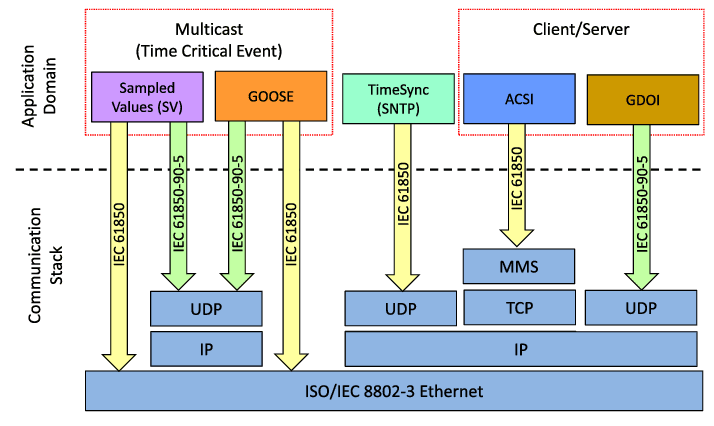The power industry is transitioning from traditional systems to smart grids. This transition requires comprehensive and integrated automation at various levels of the power grid, including substations. The IEC 61850 protocol, as an international standard, provides a common language for power system automation and therefore plays a key role in this transformation.
History and Objectives of IEC 61850
The IEC 61850 protocol was developed by the International Electrotechnical Commission (IEC) in the late 1990s to standardize communication between various equipment in substations. The protocol aimed to address the following challenges:
- Lack of a common language: In the past, different protocols were used for communication between various equipment in substations, leading to inconsistencies and increased system complexity.
- High costs: The diversity of protocols resulted in increased costs for designing, installing, and maintaining substation automation systems.
- Lack of flexibility: Traditional substation automation systems were not sufficiently responsive to changes in network needs and requirements due to their inflexibility.
- By providing a common and standardized language for communication, the IEC 61850 protocol helps to address these challenges. This protocol brings flexibility and scalability to substation automation systems and has therefore been accepted as a global standard in this field.*
Main Components of IEC 61850
The IEC 61850 protocol consists of various components that work together harmoniously. The main components of this protocol are:
- Data model: The IEC 61850 data model provides a structure for describing information related to equipment and processes in substations. This model is based on an object-oriented paradigm and assigns a unique identifier to each device in the substation.
- Communication protocols: IEC 61850 uses several communication protocols for exchanging information between devices. These protocols include MMS (Manufacturing Message Specification) and GOOSE (Generic Object-Oriented Substation Event).
- System services: IEC 61850 provides system services for tasks such as time management, synchronization, and fault detection.*

IEC 61850 Data Model
*The IEC 61850 data model is based on an object-oriented paradigm and assigns a unique identifier to each device in the substation. This model uses a hierarchy of classes and objects to organize information. Classes serve as general templates for objects, and each object is an instance of a specific class.
The IEC 61850 data model is divided into two main categories:
- Static data model: This model describes information about the structure and topology of the substation.
- Dynamic data model: This model describes information about the instantaneous status of equipment and processes in the substation.*

Benefits of IEC 61850 Protocol
The IEC 61850 protocol offers numerous advantages for power system automation, including:
- Reduced Costs: The use of a common, standardized language can significantly reduce the costs of designing, installing, and maintaining substation automation systems.
- Increased Efficiency: By providing seamless integration and easy information sharing between devices, IEC 61850 can help increase the efficiency of substation automation systems.
- Reduced Startup Time: The use of standardized and pre-defined components in IEC 61850 can significantly reduce the startup time of substation automation systems.
- Increased Reliability: IEC 61850, by providing fault detection and automatic recovery mechanisms, can help increase the reliability of substation automation systems.
- Flexibility: Due to the use of an object-oriented data model and system services, IEC 61850 is highly flexible and can be easily adapted to new needs and requirements of power networks.
Applications of IEC 61850 Protocol
The IEC 61850 protocol is used in various parts of power systems, including:
- Generating Stations: IEC 61850 can be used to automate power generation processes, monitor the performance of generators and auxiliary equipment, and optimize fuel consumption.
- Transmission Networks: IEC 61850 can be used to control and manage power flow in transmission lines, monitor line and equipment status, and prevent network overload.
- Distribution Networks: IEC 61850 can be used for demand management, rapid fault clearing, automatic isolation of faulty areas, and rapid restoration of power to customers.
Requirements and Challenges of Implementing IEC 61850
To successfully implement the IEC 61850 protocol, it is necessary to consider certain requirements and challenges. These requirements and challenges include:
- Training: Personnel and operators must be adequately trained in the use of the IEC 61850 protocol.
- Cybersecurity: Substation automation systems using IEC 61850 must be protected against cyberattacks.
- Cost: The initial investment for implementing IEC 61850 can be high.
- Compatibility with Existing Systems: IEC 61850 must be compatible with existing systems in the substation, such as SCADA and DCS systems.
The IEC 61850 protocol, as an international standard for power system automation, plays a key role in modernizing and intelligizing these networks. This protocol, by providing a common language, offers numerous advantages such as reduced costs, increased efficiency and reliability, and flexibility. Despite the requirements and challenges facing the implementation of IEC 61850, the benefits of this protocol make it a valuable investment for the power industry.
Sources
- https://webstore.iec.ch/
- https://en.wikipedia.org/wiki/IEC_61850
- https://content.nettedautomation.com/n/download/UCA%20and%2061850%20for%20dummies%20V12.pdf





